BY HOVSEP DAGHDIGIAN AND VLADIMIR TCHAGHARYAN
A number of locations and institutions in Armenia have Russian names – most of which we may have heard of; Sakharov Square in Yerevan, the Pushkin School, etc. On Yerevan’s Tigran Mets street, near the amusement park, stands the statue of Russian author Alexander Griboyedov and in Armavir province lies the village of Griboyedov. In back of the Noy Yerevan Wine factory is an inscription indicating Griboyedov’s play “Woe from Wit” was first performed here. So, who was Griboyedov?
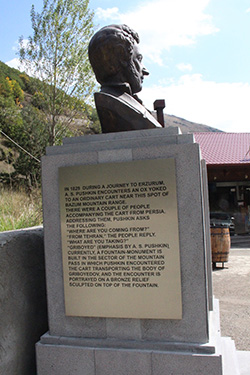

Griboyedov – Author, Diplomat:
Alexander Griboyedov was born on 4 January 1795 in Russia’s Vladimir Province to a family of minor Russian nobility. Though poor, his mother insisted he get an education. In Moscow, as a member of the nobility, he was entitled to attend the “Noble Pension” school. Subsequently at age 11 he entered the Imperial University’s faculty of literature. Though good at languages and with good grades, he demonstrated no special aptitude for literature. In 1812, when Napoleon’s army invaded Russia, Griboyedov briefly served in the army but saw no action.
After leaving the military in 1814, prior to the death of his father, he moved to Saint Petersburg. There he became involved in literary circles and befriended members of the Decembrist Russian revolutionaries who planned to overthrow Czar Nicholas I and free the serfs (indentured servants with few rights). While sympathetic to their cause, though not a member of the Decembrists, he may have known of their plans but did not participate in their activities. After their failed revolt, he came under the suspicion of the Czar and his police but was subsequently acquitted. Many of his close friends, though, were hanged, imprisoned or exiled to Siberia. During this time, among his other literary works, he started his masterpiece, a play variously interpreted as “Woe from Wit” which satirized the life of Russian high society and nobility. The play, under revision for many years, dealt with the negative consequences of being a bit too clever for one’s own good. Czarist censors, considering the play offensive, continuously denied permission for its performance though underground copies were widely circulated.
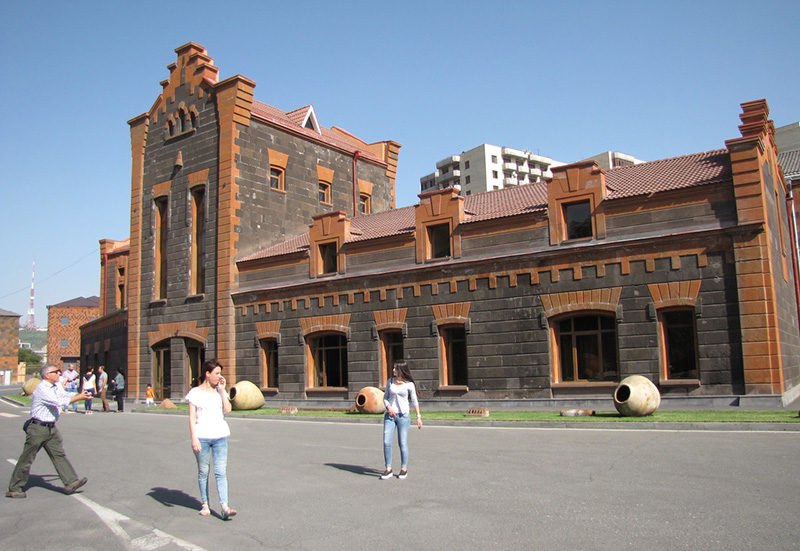

Persian Shah Abbas and the Armenians:
Due to Armenia’s strategic location, between 1513 and 1737 portions of eastern Armenia including Yerevan were fought over by Ottoman Turkey and Persia (Iran), with the area around Yerevan changing hands fourteen times. During the Ottoman-Persian war of 1603-1618 Persian Shah Abbas I implemented a scorched earth policy, devastating the Ararat valley and deporting 250,000 to 300,000 Armenians from areas as far away as Bayazid and Van to various regions of Persia. This action was intended to prohibit an invading Turkish army from living off the land. The wealthy Armenians and craftsmen from Julfa, Nakhichevan, were settled in the newly constructed town of Nor (new) Julfa near the Persian capital of Isfahan. Here, given special religious, cultural, and commercial privileges, they thrived greatly enhancing international trade and commerce in Persia. But Armenians who were settled in other areas of Persia did not fare as well. Some estimates indicate that as many as 50% of the deportees died during the deportations. Consequently, much of eastern Armenia was depopulated with Armenians constituting a minority in much of their eastern Armenian homeland.
Russo-Persian War (1804-1813) and Treaty of Gulistan:
Starting with the rule of Peter the Great (ruled 1682-1725), Russia started advancing into the Caucasus resulting in a number of Persian-Russian conflicts. In the war of 1804-1813 Persia was soundly defeated with much of Armenia, including Karabagh and Ganja, coming under Russian control. Yerevan and Nakhichevan, however, remained under Persian domination. The subsequent treaty of Gulistan (1813) left some border issues to be resolved in the future.


Russo-Persian War (1826-1828):
Following the death of Czar Alexander I in 1825, Czar Nicholas I succeeded him as Czar, and shortly thereafter brutally put down the Decemberist revolution in which many of Griboyedov’s friends were involved. Aba Mirza, the Persian crown prince and commander in Tabriz, miscalculated. Believing these recent events left Russia weak, he attacked and devastated Karabagh. Shushi, however, succeeded in defending itself for 6 weeks thus preventing further Persian advances. The Czar replaced Russian General Yermolov with General Paskevich who soundly defeated the Persians, taking Yerevan and its fortress after a 6-day siege, taking Nakhichevan, and occupying eastern Armenia up to the Arax river. In response for taking the Yerevan Fortress, including the Sardar’s (military governor’s) palace, he was bestowed with the title “Prince Paskevich Erevanski”. During a brief absence of Paskevich two of his officers, contravening orders, attacked and took the important Persian regional capital of Tabriz.
Treaty of Turkmanchai (1828):
Griboyedov, as Paskevich’s chief diplomatic advisor, maintained a hard line in the peace negotiations with Persian crown prince Abbas Mirza, stating that the Czar’s conditions for peace were not negotiable. Besides occupying Yerevan and Nakhichevan, the Russians indicated they would remain in Tabriz until a large indemnity was paid, equivalent to about twenty million silver rubles. Russia needed this money to help finance a likely war with Turkey. Paskevich, slowly advancing and capturing more territory in Persian Azerbaijan, provided an added incentive for Persia to quickly accept Russia’s terms. The Russian demands included: 1) cessation to Russia of the provinces of Yerevan and Nakhichevan; 2) confirmation of the khanates (provinces) already occupied by Russia; 3) payment of 20 million silver rubles; 4) Persian neutrality in case of war between Russia and Turkey; 5) free emigration of Persian citizens, and Armenians in particular, who wished to return and resettle in the new Russian territories – including Armenia. Persia had no choice but to accept.
Griboyedov returned to St. Petersburg to report to the Czar and to deliver a copy of the Turkmanchai Treaty signed by the Shah. In Russia he also visited his friend, author Alexander Pushkin, whom he had not seen for many years. Returning to Persia through Georgia, where he got married, he then proceeded to Tehran as Russian plenipotentiary where he joined other Russian diplomats for the final steps of ratification and implementation of the treaty. The Persians were offended with the behavior of the Russians, the humiliating conditions being forced upon them, and especially Russian repatriation of Islamized Armenians in Persia. The British, who had a significant presence in Persia, were holding back payments that the Persians believed they were owed. Since the British did not want Russia to linger in Persia, they paid the Persians at least part of what they owed them. The Persians paid the indemnity and the Russians withdrew. In February 1829 an irate mob gathered outside the Russian mission, forced its way in and, with the exception of a sole survivor, killed all the Russians including Griboyedov.
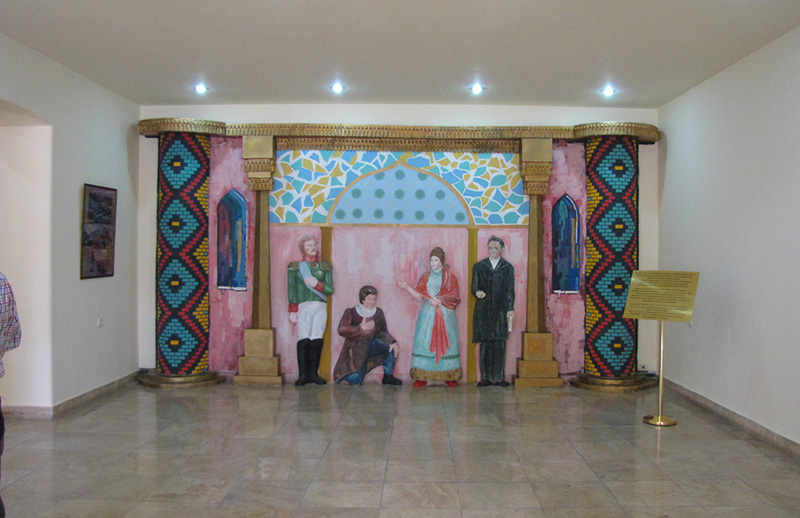

Woe from Wit:
In the days after taking Yerevan fortress, officers of the 7th Carabiners, later renamed the “Erevan Regiment”, celebrated their victory by performing Griboyedov’s play Woe from Wit in the fortress, in Griboyedov’s presence. General Paskevich, aware that performance of this play was still forbidden, nevertheless let it pass. This was the first performance of “Woe from Wit” (in Armenian “Խելքից Պատուհասը”) anywhere and it occurred in Armenia. An authorized, uncensored performance of the play was not performed until well after Griboyedov’s death.
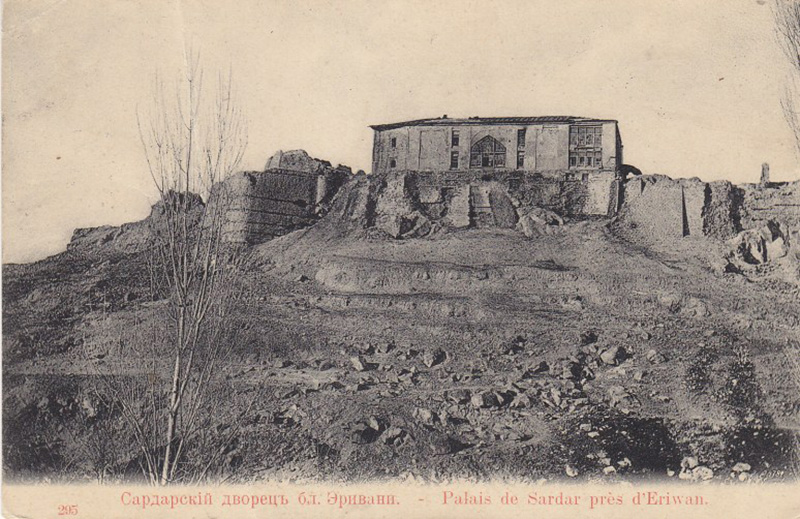

Yerevan Fortress:
The Yerevan fortress was originally built during the Turkish occupation of Yerevan (1582-1583) and destroyed by an earthquake in 1679. Later, when Persia occupied Yerevan, the fortress was rebuilt using forced labor. During the Soviet era, in the 1930s, the fortress was completely demolished with only traces of it remaining. Then the Yerevan Ararat Brandy Factory was established on the site in 1877. The current building was designed by noted architect Rafael Israelyan (1908-1973) who also designed the Sardarabad Memorial on the 50th anniversary of the Armenian Genocide, the Musa Dagh memorial in Musaler village, and the Bash-Aparan memorial. The current owner of the Noy Brandy and Wine Factory is Gagik Tsarukyan.
On a wall in back of the factory is an inscription commemorating the site of the first performance of “Woe from Wit”. Tours of the factory take visitors by the stage where the play was first performed. Other features of the tour, besides the wine or brandy tasting, are displays of old cannons and artifacts, and in the basement sections of wall which were part of the old fortress.
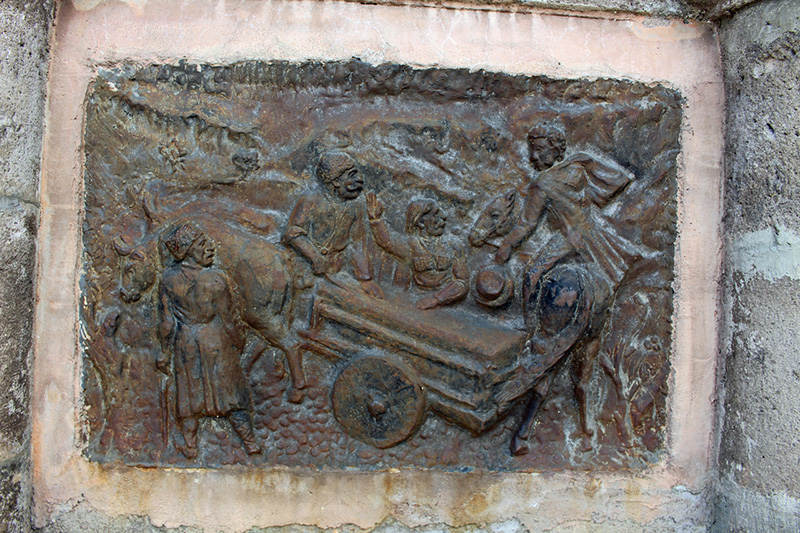

The Search for Griboyedov:
In June, 1829 Griboyedov’s body was being transported by ox-cart from Tehran to Tiflis’ St. David church for burial. As it passed through Nakhichevan, a memorial service was conducted in an Armenian church there. The cart continued traveling over the mountains north-west of Lake Sevan. At that time Alexander Pushkin was traveling to Kars to visit his brother who was serving in the Russian army. Pushkin, seeing the cart, approached and asked the drivers “What are you carrying?” “The body of Griboyedov”, they replied. This was the first Pushkin learned of the death of his dear friend. The pass was subsequently named “Pushkin Pass”. During the Soviet era a monument was erected there to memorialize this event. The road through the Pushkin Pass is now seldom used, though it is still passable. A tunnel now passes under the mountain easing travel from the south towards Stepanavan. The monument has been moved to the highway north of the tunnel.
A search for the memorial first led us to Dilijan, which some sources cited as the memorial’s site. A woman working in a restaurant there helped us determine its actual location. Back in Yerevan the manager of the Green Bean restaurant helped, as did Hagop, a local taxi driver with a superb knowledge of Armenia. As we headed towards Stepanavan, at the tunnel’s southern entrance there appeared a number of statues commemorating Pushkin and Griboyedov. Tunnel workers there directed us to the monument’s location north of the tunnel, on a slight rise west of the highway. The monument depicts the meeting of Puskhin and Griboyedov’s remains.
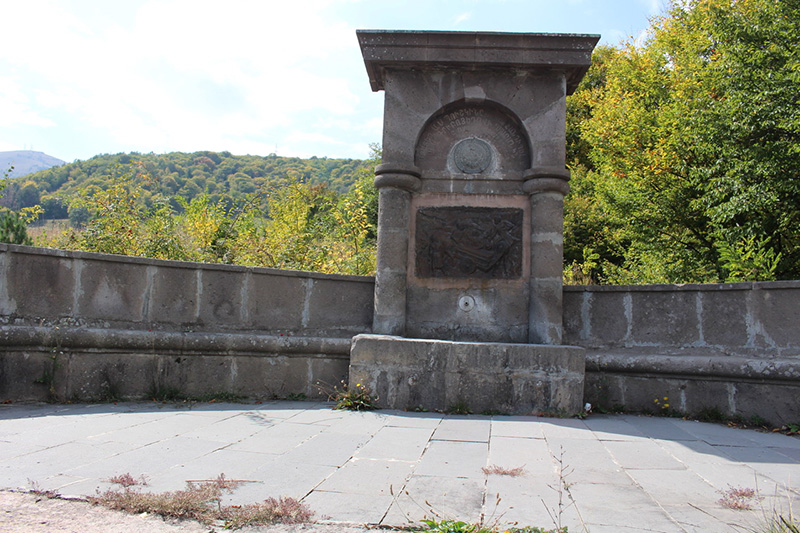

Prof. George Bournoutian has written extensively on the history of the Caucasus and the history of Eastern Armenia. After the Treaty of Turkmanchai, tens of thousands of Armenian, and their descendants, forcibly displaced to Persia returned to Russian Armenia, as did tens of thousands of Armenians from Turkish occupied Armenia. By 1836 Armenians went from being a minority in much of their Caucasian homeland to a majority. Armenians in many villages in southern Armenia will relate that their ancestors came from Persia after the treaty was signed. One villager, however, indicated though his ancestors came from Persia, he emphatically stated “We are not Barsgahye!” (“We are not Persian Armenians”), we are from here, indicating his family’s roots are in Armenia.
In Russia and Armenia Griboyedov is a highly regarded author. Friends from Armenia tell of memorizing parts of “Woe from Wit” in school. Of course, in Armenia Griboyedov is also honored as the architect of the Turkmenchai treaty. In Iran (modern Persia) he is despised.
References:
George Bournoutian, “Russia and the Armenians of Transcaucasia, 1797-1889, A documentary Record”, Mazda Publishers, 1998
George Bournoutian, “Eastern Armenia in the Last Decades of Persian Rule, 1807-1828”, Undena Publishers,b 1982
George Bournoutian, “A Concise History of the Armenian People”, Mazda Publishers, 2006
Laurence Kelly, “Diplomacy and Murder in Tehran”, I. B. Tauris, 2002
Photo credits:
1, 2, 3, 5, 7 & 8 taken by Hovsep Daghdigian.
4 & 6 are from web sources indicating they are for public use with no copyright restrictions. For details see below:
Siege of Yerevan Fortress photo is from: https://en.wikipedia.org/wiki/Erivan_Fortress#/media/File:Capture_of_Erivan_Fortress_by_Russia,1827(by_Franz_Roubaud).jpg
Sardar’s Palace photo is from: https://commons.wikimedia.org/wiki/File:Serdar%27s_Palace_near_Erivan.jpg

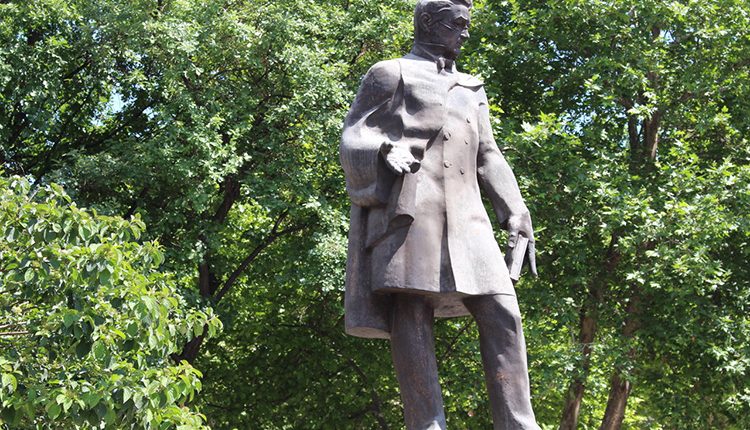

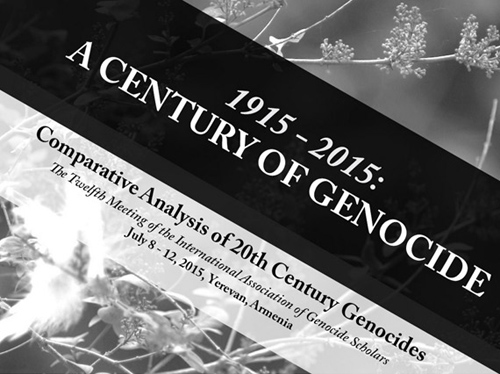

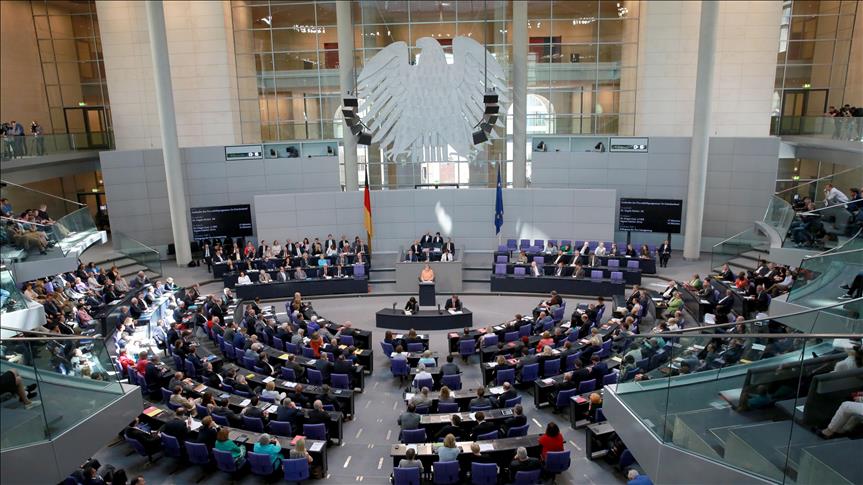





1 comment
Thank you for this informative article!